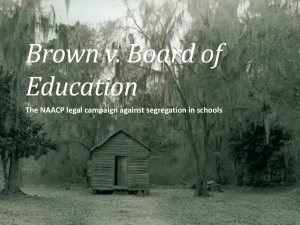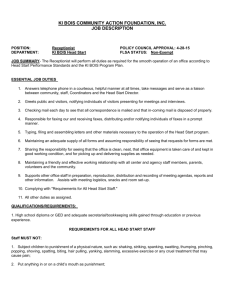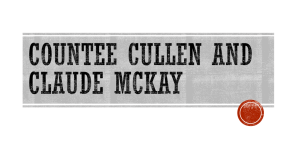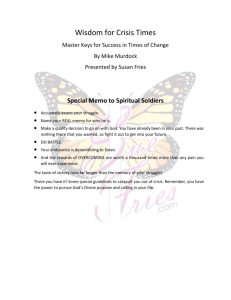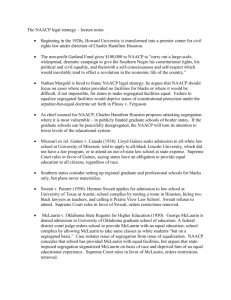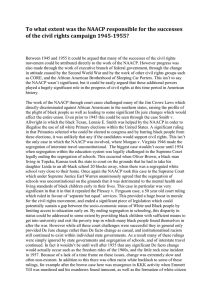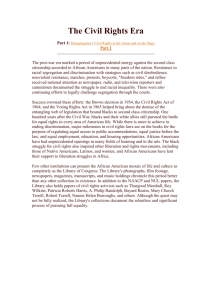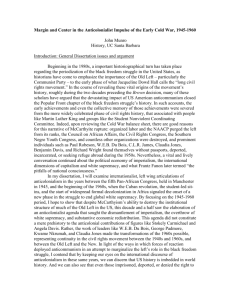Seminar Leader Background Notes
advertisement
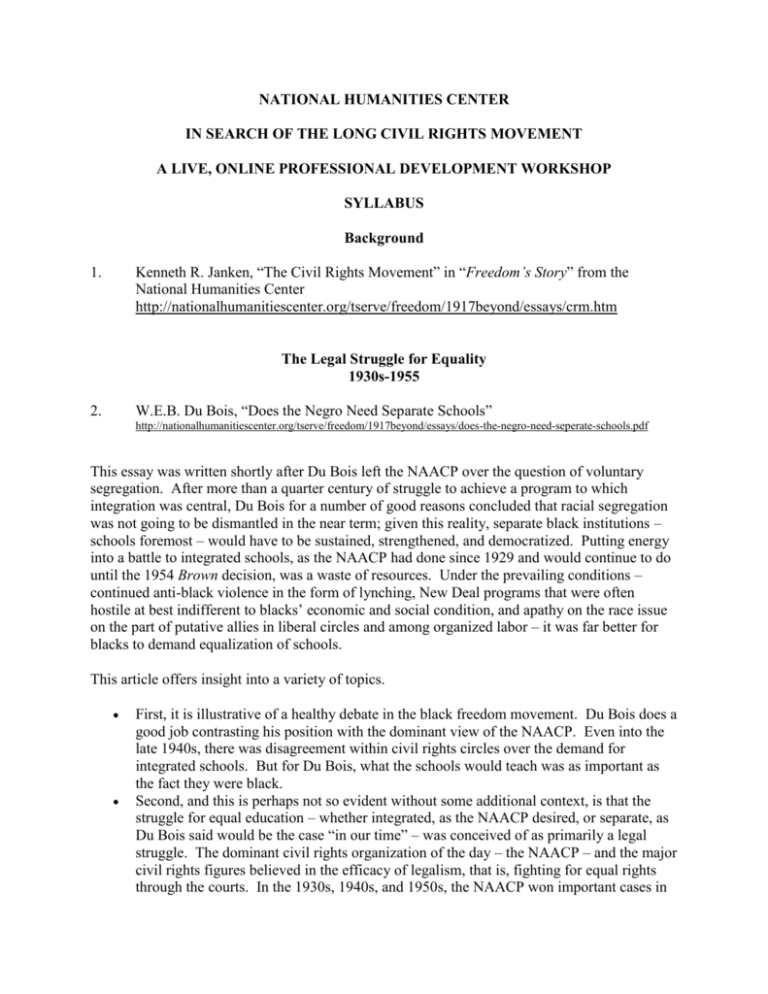
NATIONAL HUMANITIES CENTER IN SEARCH OF THE LONG CIVIL RIGHTS MOVEMENT A LIVE, ONLINE PROFESSIONAL DEVELOPMENT WORKSHOP SYLLABUS Background Kenneth R. Janken, “The Civil Rights Movement” in “Freedom’s Story” from the National Humanities Center http://nationalhumanitiescenter.org/tserve/freedom/1917beyond/essays/crm.htm 1. The Legal Struggle for Equality 1930s-1955 W.E.B. Du Bois, “Does the Negro Need Separate Schools” 2. http://nationalhumanitiescenter.org/tserve/freedom/1917beyond/essays/does-the-negro-need-seperate-schools.pdf This essay was written shortly after Du Bois left the NAACP over the question of voluntary segregation. After more than a quarter century of struggle to achieve a program to which integration was central, Du Bois for a number of good reasons concluded that racial segregation was not going to be dismantled in the near term; given this reality, separate black institutions – schools foremost – would have to be sustained, strengthened, and democratized. Putting energy into a battle to integrated schools, as the NAACP had done since 1929 and would continue to do until the 1954 Brown decision, was a waste of resources. Under the prevailing conditions – continued anti-black violence in the form of lynching, New Deal programs that were often hostile at best indifferent to blacks’ economic and social condition, and apathy on the race issue on the part of putative allies in liberal circles and among organized labor – it was far better for blacks to demand equalization of schools. This article offers insight into a variety of topics. First, it is illustrative of a healthy debate in the black freedom movement. Du Bois does a good job contrasting his position with the dominant view of the NAACP. Even into the late 1940s, there was disagreement within civil rights circles over the demand for integrated schools. But for Du Bois, what the schools would teach was as important as the fact they were black. Second, and this is perhaps not so evident without some additional context, is that the struggle for equal education – whether integrated, as the NAACP desired, or separate, as Du Bois said would be the case “in our time” – was conceived of as primarily a legal struggle. The dominant civil rights organization of the day – the NAACP – and the major civil rights figures believed in the efficacy of legalism, that is, fighting for equal rights through the courts. In the 1930s, 1940s, and 1950s, the NAACP won important cases in the U.S. Supreme Court that chipped away at the edifice of segregation in public education, culminating in the Brown decision of 1954. For most of the civil rights establishment, mass action was of secondary, even tertiary importance, and the organized direct action of ordinary people was limited to joining an NAACP branch, contributing money to the cause, and writing elected officials. Third, the essay shows the salient role of battling feelings of inferiority and powerlessness in the process of building a freedom struggle. Du Bois critiques “an utter lack of faith on the part of the Negroes that their race can do anything really well” (330). He goes on to adumbrate the type of education that will result in advancement of the race and will contribute to the liberation of people of color around the globe. The Direct Action Phase 1955-1960s 3. Student Nonviolent Coordinating Committee Statement of Purpose Note: http://nationalhumanitiescenter.org/pds/maai3/protest/text2/text2read.htm Text: http://nationalhumanitiescenter.org/pds/maai3/protest/text2/snccstatementofpurpose.pdf 4. Ella Baker “Bigger Than a Hamburger” http://www.crmvet.org/docs/sncc2.htm The Montgomery bus boycott of 1955-56 offered an alternative to legalism: ordinary people taking action themselves to gain their freedom. The Southern Christian Leadership Conference was founded the following year to take advantage of the momentum created by the boycott. An organization of clergy and built around the personality of Martin Luther King, the SCLC floundered in its first years of existence, unable to replicate the success in Montgomery. It was not until the student sit-ins in 1960 in Greensboro, Nashville, Atlanta, and elsewhere, that direct action gained much traction as a sustained strategy for people to participate in their own liberation. In April 1960, a little more than two months after the start of the sit-in movement, students from across the South gathered at Shaw University in Raleigh and founded the Student Nonviolent Coordinating Committee. Ella Baker’s brief article, “Bigger than a Hamburger,” appeared in the Southern Patriot, the publication of the Southern Conference Educational Fund, which was an interracial, left-leaning organization that supported the southern black freedom movement. The article not only announced the formation of SNCC, it also captured some of the unique qualities of the burgeoning student movement. SNCC would be democratic and would operate on the principle that those who carried out the work were responsible for making the decisions. Although it adhered to nonviolent tactics, it was markedly different from the Southern Christian Leadership Conference, which was perceived as being led by a single personality, and the NAACP, which disdained mass action in favor of legalism. 5. “An Appeal for Human Rights” http://www.crmvet.org/docs/aa4hr.htm Julian Bond of Atlanta, who would become one of the most important leaders in SNCC and would spend a subsequent lifetime in the struggle, claimed that in the beginning, “We were really much into the hamburger. That was the issue; the hamburger.…To our mind, lunchcounter segregation was the greatest evil facing black people in the country and if we could eliminate it, we would be like gods” (The River of No Return, pp. 43, 45). And yet by the time the sit-in movement swept over his city, the students there demonstrated a rather sophisticated understanding of the relationship between segregation of public accommodations and the fundamental inequalities of the American economic, political, and social systems. It was this type of analysis that would guide SNCC in its work especially in Mississippi, Alabama, and Georgia in the first half of the 1960s. Even if initial protests in local areas were sparked by discrimination at lunch counters, the Student Nonviolent Coordinating Committee worked with local people and conducted education to connect local grievances with systemic issues. 6. Malcolm X, “The Ballet or the Bullet” Note: http://nationalhumanitiescenter.org/pds/maai3/protest/text8/text8read.htm Text: http://www.hartford-hwp.com/archives/45a/065.html Where to start with Malcolm X? This is but one speech of many, and it is extremely rich. Sprinkled through it are truly memorable lines. “Well, I am one who doesn't believe in deluding myself. I'm not going to sit at your table and watch you eat, with nothing on my plate, and call myself a diner. Sitting at the table doesn't make you a diner, unless you eat some of what's on that plate. Being here in America doesn't make you an American. Being born here in America doesn't make you an American.” And, “No, I'm not an American. I'm one of the 22 million black people who are the victims of Americanism. One of the 22 million black people who are the victims of democracy, nothing but disguised hypocrisy…And I see America through the eyes of the victim. I don't see any American dream; I see an American nightmare.” And, of course, the title: “The Ballot or the Bullet.” He deflates his enemy by calling whites insane and silly and blinded by their bias; he pokes fun at them, thereby making them less fearsome and boosting the confidence of his audience.
